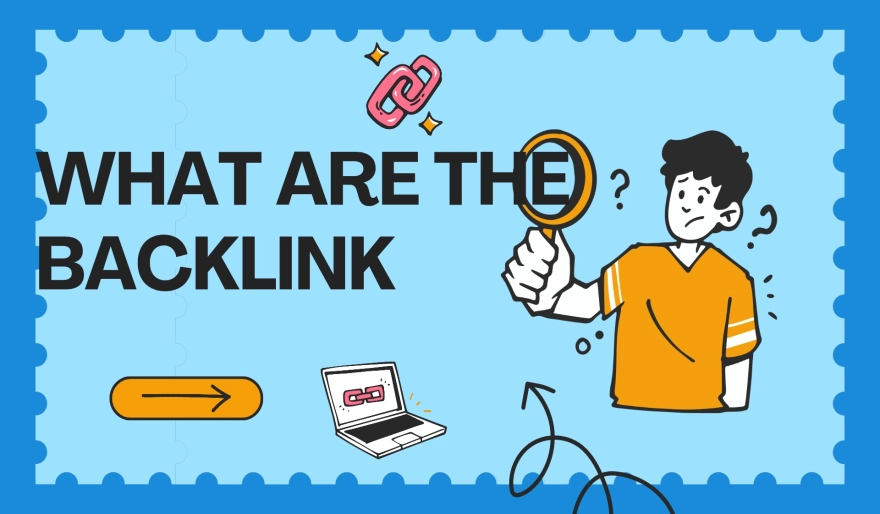Backlinks Explained: What They Are & Why They’re Crucial for SEO Success
7 min read If you're diving into the world of SEO, you've probably come across the term "backlinks." But what exactly are they, and why do they play such a massive role in how your website performs online? May 05, 2025 07:10
Whether you're a blogger, startup founder, digital marketer, or small business owner, understanding backlinks is key to building online authority and driving organic traffic.
In this complete guide, we’ll cover:
-
What backlinks are
-
How they work
-
Why they matter for SEO
-
Types of backlinks
-
How to build high-quality backlinks
-
What to avoid (black hat SEO)
-
And more!
What Are Backlinks? 🧐
In simple terms, a backlink is a link from one website to another.
Let’s break it down:
Imagine you write a great blog post about productivity tools, and a popular tech website finds it valuable. They mention your article and hyperlink it in their own blog post. That hyperlink pointing to your site is a backlink.
Also known as inbound links, backlinks act like votes of trust. The more reputable sites link to you, the more trustworthy and authoritative your site appears to search engines like Google.
Why Are Backlinks So Important for SEO? 🚀
Backlinks aren’t just helpful — they’re essential. Google has confirmed that backlinks are one of the top three ranking factors in its algorithm (along with content quality and user experience).
Here’s how backlinks work to your advantage:
| Benefit | Why It Matters |
|---|---|
| Boosts Rankings | Quality backlinks help your pages rank higher on Google and other search engines. |
| Drives Referral Traffic | People click on backlinks to visit your site, giving you targeted traffic. |
| Increases Indexing Speed | Search engine bots follow links, so backlinks help them find and index your content faster. |
| Builds Domain Authority | The more reputable links you get, the higher your website’s authority score grows. |
| Strengthens Credibility | If well-known sources link to you, your brand earns more trust from users and search engines. |
| Improves Lead Generation & Sales | More traffic = more opportunities to convert readers into customers or subscribers. |
Types of Backlinks (And Which Ones You Want) 📚
Not all backlinks are created equal. Some are goldmines for SEO — others can do more harm than good.
Here’s a breakdown of different types of backlinks:
| Type | Definition | SEO Value |
|---|---|---|
| DoFollow | Standard backlink that passes link juice and helps SEO. | High |
| NoFollow | Tells search engines not to pass link juice. Still good for traffic and visibility. | Medium |
| UGC (User Generated Content) | Added by users (e.g., comments, forums); marked with rel="ugc". |
Low |
| Sponsored | Paid or affiliate links, marked with rel="sponsored". |
Low |
| Editorial | Naturally placed by other sites referencing your content. | Very High |
| Guest Post | Placed in articles you write for other blogs. | High |
| Forum/Directory | Links in forum signatures or online directories. Can be useful, but often lower quality. | Low to Medium |
Pro Tip: Aim for high-quality, contextual backlinks from niche-relevant and authoritative domains.
How to Build High-Quality Backlinks 🧱
Here’s where most websites struggle — getting backlinks. But with the right strategies, you can build a strong, natural backlink profile over time.
✅ 1. Create Exceptional, Link-Worthy Content
-
Publish in-depth guides, tutorials, research, or industry reports.
-
Content that solves problems gets shared and linked to more often.
-
Infographics and tools (like calculators or templates) are backlink magnets.
✅ 2. Use Guest Posting to Expand Reach
-
Write for reputable blogs in your niche.
-
Include a contextual backlink within your author bio or article content.
-
Focus on quality over quantity.
✅ 3. Outreach: Ask for Links (The Right Way)
-
Reach out to bloggers, journalists, or content creators who cover related topics.
-
Show them how your content adds value.
-
Keep it personal, concise, and polite.
✅ 4. Reclaim Lost or Broken Backlinks
-
Use SEO tools like Ahrefs, SEMrush, or Screaming Frog to find broken backlinks.
-
Contact site owners and suggest your updated URL as a fix.
✅ 5. Get Featured on Resource Pages or Roundups
-
Look for posts like “Top 10 Tools for [Industry]” or “Best Websites for [Topic].”
-
Pitch your site as a valuable addition to these curated lists.
What Makes a Good Backlink? ⭐
High-quality backlinks have certain traits in common. Aim for links that are:
-
From relevant, niche-related websites
-
From high-authority domains (use Moz’s Domain Authority or Ahrefs’ Domain Rating)
-
Contextual, meaning they appear naturally within the content
-
From real, editorial placements, not link farms or spammy sources
-
Using diverse anchor text (not always exact-match keywords)
Backlink Mistakes to Avoid (Black Hat SEO) ❌
Be careful — bad backlinks can hurt your site more than help.
Avoid:
-
Buying backlinks (against Google’s guidelines)
-
Using automated link building tools
-
Participating in PBNs (Private Blog Networks)
-
Keyword-stuffed anchor text
-
Getting links from spammy, irrelevant, or low-quality sites
If Google suspects you’re gaming the system, your site may be penalized — and recovery is often difficult.
How to Monitor Your Backlinks 🕵️♂️
Monitoring your backlink profile is just as important as building it.
Use tools like:
-
Ahrefs
-
Moz Link Explorer
-
SEMrush
-
Google Search Console
These tools help you:
-
Track your backlink growth
-
Identify lost or broken links
-
Analyze competitors’ backlink strategies
-
Disavow toxic backlinks (if needed)
Conclusion: Backlinks Are the Currency of the Internet 💡
Backlinks are the foundation of a strong SEO strategy. They improve your visibility, boost your authority, and drive high-converting traffic to your site.
Focus on earning backlinks, not manipulating them. Build relationships, create amazing content, and be genuinely useful. Over time, your backlink profile will grow — and so will your rankings, traffic, and revenue.
Ready to take your SEO to the next level?
Start building smart backlinks today — your future rankings will thank you!
User Comments (0)
Popular Apps










Editor's Choice










 WP Theme
WP Theme Android
Android iOS
iOS Windows
Windows Mac
Mac Linux
Linux Play Station
Play Station Xbox
Xbox Steam
Steam Wordpress
Wordpress